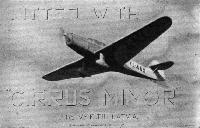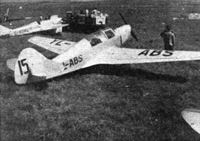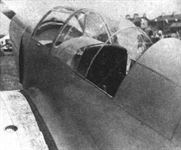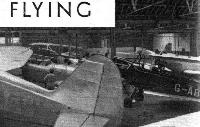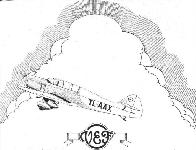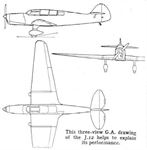
I-11 / I-12 / I-17
VEF. Самолеты
Базирующееся в Риге латвийское государственное предприятие "Valsts Elektrotechniska Fabrika" (VEF) в 1935 году организовало авиастроительное подразделение, главным конструктором которого стал Карлис Ирбитис. Среди проектов VEF преобладали низкопланы цельнодеревянной конструкции, первым из которых стал двухместный I-11. В 1937 году он совершил 1000-км перелет вокруг Латвии, продолжавшийся 5 ч 30 мин. На его базе был создан моноплан с закрытой кабиной I-12, совершивший первый полет в июне 1937.
<...>
Описание:
- I-11 / I-12 / I-17
- Flight, August 1939
LATVIAN EFFICIENCY
Фотографии
-
Flight 1937-05 / Flight
Регистрационный номер: YL-AAX [4] POWER FROM BROUGH. The V.E.F. J.-11, a light Latvian private-owner type built round one of the new Cirrus Minor engines. The speed figures quoted are 124 m.p.h. cruising and 149 m.p.h. maximum, which, for 90 h.p. and two up is good going in any language. The mounting of the tail plane is one outlandish feature to note. It appears that the occupant of the front seat has quite an extraordinarily good prospect.
CIRRUS-MINOR-ENGINED, this Latvian V.E.F. J-11 monoplane recently made a circuit of its native country in 5 hrs. 20 mins. for the 655 miles, including several demonstration stops; the average flying speed was 125 m.p.h. The machine is shortly coming to England, and those interested in demonstrations should write to Mr. Janis Vitols, 24, Queensborough Terrace, London, W.2. -
Flight 1937-04 / Flight Advertisements
Регистрационный номер: YL-AAX [4] The V.E.F. J-11 machine CIRRUS " MINOR." Top speed nearly 150 m.p.h.
-
Flight 1936-10 / Flight Advertisements
Регистрационный номер: YL-AAX [4]
-
Flight 1937-08 / Flight
Регистрационный номер: YL-ABG [3] The fascinating little Latvian V.E.F. 12 which was judged the smartest machine on parade.
-
Мировая Авиация 248
Регистрационный номер: YL-ABG [3] I-12 был оснащен 90-сильным (67 кВт) ПД Cirrus Minor; около 12 таких самолетов были построены для гражданского и военного использования. Некоторые из них служили в ВВС Латвии.
Whilst the early Irbitis designs were high-wing monoplanes, all the later aircraft were low-wing types (shown, I-12). -
Flight 1939-08 / Flight
Регистрационный номер: YL-ABS [2] The clean lines of the V.E.F. are obvious in this photograph, taken during the Isle of Man races. The ailerons do not, as they appear, extend from centre section to wing tip - the inner portions are slotted flaps.
-
Flight 1939-12 / Flight
Регистрационный номер: YL-ABS [2] An untouched photograph taken by Flight with the miniature camera. It shows the V.E.F. J12 cabin monoplane at Ronaldsway, Isle of Man.
-
Flight 1937-09 / Flight
Регистрационный номер: YL-ABG [3] The two leading machines, the Klemm in the foreground and the V.E.F. on the left. Two of the four Gauntlets at the meeting may be distinguished in the background.
Другие самолёты на фотографии: Gloster Gauntlet - Великобритания - 1929Klemm Kl.35 / Kl.106 - Германия - 1935
-
Jane's All the World Aircraft 1938 / 03 - All the world's aeroplanes
The V.E.F. I-12 Two-seat Light Cabin Monoplane (90 h.p. Cirrus "Minor" engine).
-
Flight 1938-01 / Flight
ECONOMICAL SPEED: The Valsts Elektrotechniska Fabrika J.12, for which Rollasons of Croydon are agents in this country. With an 80/90 Cirrus Minor engine this little two-seater cruises at 123 m.p.h. and has a maximum of 149 m.p.h. One or two minor modifications are being made to the later production machines in order to bring them into line with British C. of A. requirements. Among other interesting features the J.12 has manually applied split flaps and differentially operated slotted ailerons.
-
Flight 1939-08 / Flight
The transparent enclosure arrangement on the J.12. The rear portion slides and can be left in any position, while that over the front seat lifts. There is a wide luggage locker behind the rear seat.
-
Flight 1937-10 / Flight
THE ILL WIND: A corner of Rollason's hangar at Croydon. In the foreground is a Stinson Reliant, with the little Latvian V.E.F. J.12 behind it and the South African Junkers Junior on the right. One of I.A.F.'s Curtiss Condor freighters can be seen in the far distance.
Другие самолёты на фотографии: Curtiss Condor 18 - США - 1929Junkers A 50 Junior - Германия - 1929Stinson Reliant - США - 1933
-
Air Enthusiast 1992-12 / C.Davis - Latvia's Little Hawk
Almost ready. An excellent photo showing the I-16 nearing completion. Many structural details are readily apparent. A VEF I-12 is in the foreground.
Другие самолёты на фотографии: Irbitis, VEF I-14 / I-15 / I-16 - Латвия - 1937
-
Air International 1988-01 / In print
The V.E.F. I-17 basic trainer.
Aircraft designed in Latvia by Karlis Irbitis are numerous, ranging up to the sporty-looking I-17 trainer.
-
Flight 1939-08 / Flight
This three-view G.A. drawing of the J.12 helps to explain its performance.
- Фотографии


